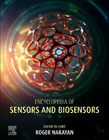
Encyclopedia of Sensors and Biosensors provides unique foundational level information on the rapidly growing sensor community. The book covers innovations in materials, designs, devices and software that find their way into new types of sensors. Sections include over 1000 color images, including representations of sensor design, sensor manufacturing, and assessments of sensor performance. In addition, applications of sensors in healthcare, food safety, environmental engineering and other fields are discussed, making this a truly interdisciplinary work. The book is structured using a logical and thematic approach, with chapters taking a balanced viewpoint, listing both advantages and disadvantages. Perfect for those learning their trade in both academia and industry, this vital reference work will serve many groups, including chemists, engineers, biological scientists, clinicians, and industrial researchers. Provides students and new scientists with a comprehensive, 'one-stop' resource in sensor technology, giving them a solid grounding in unfamiliar topics Presents the most up-to-date reference resource available, providing truly interdisciplinary coverage across all aspects of sensor technology Ideal for researchers/scientists in both academia and industry Allows experienced researchers to put their work into a broader context Includes over 1000 color images that detail the full range of sensors and devices covered INDICE: Section 1: Types 1. Physical sensors (e.g., fluorophore sensors, thermal sensors, optical sensors, mechanical sensors, and acoustic sensors) 2. Chemical sensors (e.g., radiation sensors, electrochemical sensors, enzyme-linked immunosorbent assay sensors, aptamer sensors) 3. Biological sensors (e.g., cell and tissue-containing sensors) 4. Combinatorial sensors 5. New sensing technologies Section 2: Materials and devices 6. Sensing materials (e.g., ceramics, metals, polymers, composites, and nanomaterials) 7. Sensing interfaces (e.g., self-cleaning sensors) 8. Existing sensing devices Section 3: Development 9. Sensor design 10. Sensor fabrication techniques 11. Sensor instrumentation 12. Sensor characterization techniques 13. Sensor packaging (e.g., lab-on-a-chip sensors and disposable sensors) 14. Sensor testing 15. Sensor reliability improvement Section 4: Integration 16. Sensor signal processing 17. Sensor integration 18. Sensor networks 19. Fata processing 20. Data analysis (e.g., machine learning approaches) 21. Sensor testing 22. Sensor reliability (including of sensor fouling) 23. Clinical trials 24. Storage, maintenance, and long-term use 25. Large-scale manufacturing and commercialization 26. Standards 27. Regulatory considerations 28. Ethical considerations for use with humans and animals Section 5: Applications 29. Environmental sensors 30. Electronic-nose sensors 31. Agriculture sensors 32. Climate and ecological sensors 33. Food safety sensors 34. Homeland security sensors (e.g., nuclear, biological and chemical sensors) 35. Medical sensors 36. Nuclear technology sensors 37. Aerospace sensors 38. Veterinary sensors Section 6: Future forecast
- ISBN: 978-0-12-822548-6
- Editorial: Elsevier
- Encuadernacion: Cartoné
- Páginas: 2140
- Fecha Publicación: 01/10/2022
- Nº Volúmenes: 1
- Idioma: Inglés
